Finance Report: Financial Analysis of Global Market Expansion Strategy
VerifiedAdded on 2022/12/27
|21
|2784
|72
Report
AI Summary
This finance report analyzes the potential for Dionysus International to expand its business globally, focusing on Singapore, South Korea, and India as potential markets. The report examines purchasing power parity (PPP) trends, revealing significant discrepancies between US dollar prices and local currency prices in each market, particularly in India. It assesses the implications of foreign exchange rates, highlighting product undervaluation in local currencies. The report explores arbitrage opportunities, calculating potential profits from investing in India. It also discusses the business implications of Covered Interest Arbitrage (CIA) and Uncovered Interest Arbitrage (UIA) and the importance of tracking monetary markets. Based on the analysis, the report recommends that Dionysus International expand its operations in India due to the favorable arbitrage opportunities and the country's large market potential. The report concludes by emphasizing the potential for maximizing profits through strategic financial decisions.

Running head: FINANCE
Finance
Name of the Student:
Name of the University:
Authors Note:
Finance
Name of the Student:
Name of the University:
Authors Note:
Paraphrase This Document
Need a fresh take? Get an instant paraphrase of this document with our AI Paraphraser
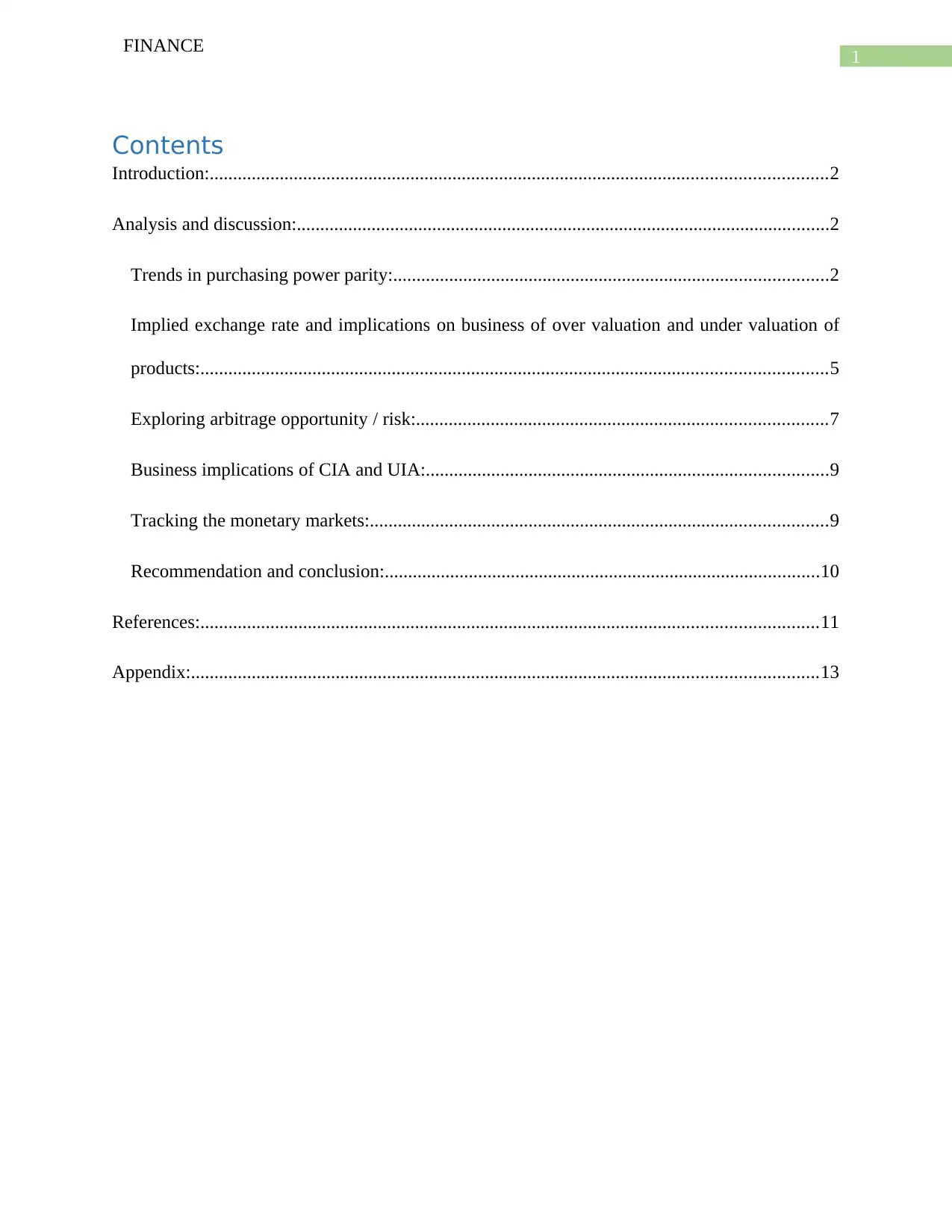
1
FINANCE
Contents
Introduction:....................................................................................................................................2
Analysis and discussion:..................................................................................................................2
Trends in purchasing power parity:.............................................................................................2
Implied exchange rate and implications on business of over valuation and under valuation of
products:......................................................................................................................................5
Exploring arbitrage opportunity / risk:........................................................................................7
Business implications of CIA and UIA:......................................................................................9
Tracking the monetary markets:..................................................................................................9
Recommendation and conclusion:.............................................................................................10
References:....................................................................................................................................11
Appendix:......................................................................................................................................13
FINANCE
Contents
Introduction:....................................................................................................................................2
Analysis and discussion:..................................................................................................................2
Trends in purchasing power parity:.............................................................................................2
Implied exchange rate and implications on business of over valuation and under valuation of
products:......................................................................................................................................5
Exploring arbitrage opportunity / risk:........................................................................................7
Business implications of CIA and UIA:......................................................................................9
Tracking the monetary markets:..................................................................................................9
Recommendation and conclusion:.............................................................................................10
References:....................................................................................................................................11
Appendix:......................................................................................................................................13
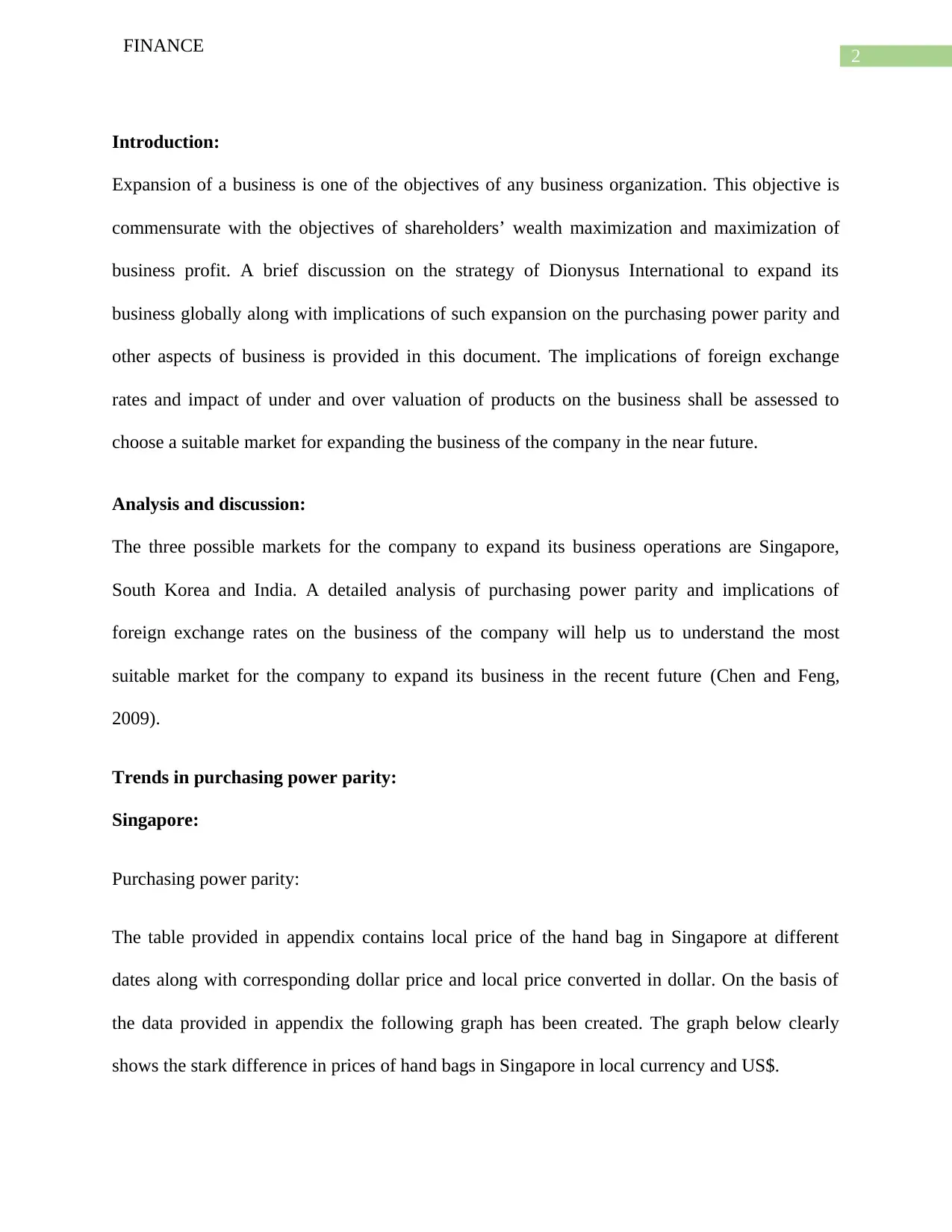
2
FINANCE
Introduction:
Expansion of a business is one of the objectives of any business organization. This objective is
commensurate with the objectives of shareholders’ wealth maximization and maximization of
business profit. A brief discussion on the strategy of Dionysus International to expand its
business globally along with implications of such expansion on the purchasing power parity and
other aspects of business is provided in this document. The implications of foreign exchange
rates and impact of under and over valuation of products on the business shall be assessed to
choose a suitable market for expanding the business of the company in the near future.
Analysis and discussion:
The three possible markets for the company to expand its business operations are Singapore,
South Korea and India. A detailed analysis of purchasing power parity and implications of
foreign exchange rates on the business of the company will help us to understand the most
suitable market for the company to expand its business in the recent future (Chen and Feng,
2009).
Trends in purchasing power parity:
Singapore:
Purchasing power parity:
The table provided in appendix contains local price of the hand bag in Singapore at different
dates along with corresponding dollar price and local price converted in dollar. On the basis of
the data provided in appendix the following graph has been created. The graph below clearly
shows the stark difference in prices of hand bags in Singapore in local currency and US$.
FINANCE
Introduction:
Expansion of a business is one of the objectives of any business organization. This objective is
commensurate with the objectives of shareholders’ wealth maximization and maximization of
business profit. A brief discussion on the strategy of Dionysus International to expand its
business globally along with implications of such expansion on the purchasing power parity and
other aspects of business is provided in this document. The implications of foreign exchange
rates and impact of under and over valuation of products on the business shall be assessed to
choose a suitable market for expanding the business of the company in the near future.
Analysis and discussion:
The three possible markets for the company to expand its business operations are Singapore,
South Korea and India. A detailed analysis of purchasing power parity and implications of
foreign exchange rates on the business of the company will help us to understand the most
suitable market for the company to expand its business in the recent future (Chen and Feng,
2009).
Trends in purchasing power parity:
Singapore:
Purchasing power parity:
The table provided in appendix contains local price of the hand bag in Singapore at different
dates along with corresponding dollar price and local price converted in dollar. On the basis of
the data provided in appendix the following graph has been created. The graph below clearly
shows the stark difference in prices of hand bags in Singapore in local currency and US$.
⊘ This is a preview!⊘
Do you want full access?
Subscribe today to unlock all pages.

Trusted by 1+ million students worldwide

3
FINANCE
It is clear from the above graph that the purchasing power parity does not hold true in case of the
prices of hand bags in these two different markets. There is significant difference in local price
denominated in local currency in Singapore and local price denominated in US$ using
appropriate exchange rate existing on relevant dates (Review Editor, 2006).
South Korea:
The graph below shows the prices of hand bag in local market in South Korea in the local
currency and in US$ (converting the local price denominated in local currency to US$ using the
relevant rate of foreign exchange).
FINANCE
It is clear from the above graph that the purchasing power parity does not hold true in case of the
prices of hand bags in these two different markets. There is significant difference in local price
denominated in local currency in Singapore and local price denominated in US$ using
appropriate exchange rate existing on relevant dates (Review Editor, 2006).
South Korea:
The graph below shows the prices of hand bag in local market in South Korea in the local
currency and in US$ (converting the local price denominated in local currency to US$ using the
relevant rate of foreign exchange).
Paraphrase This Document
Need a fresh take? Get an instant paraphrase of this document with our AI Paraphraser
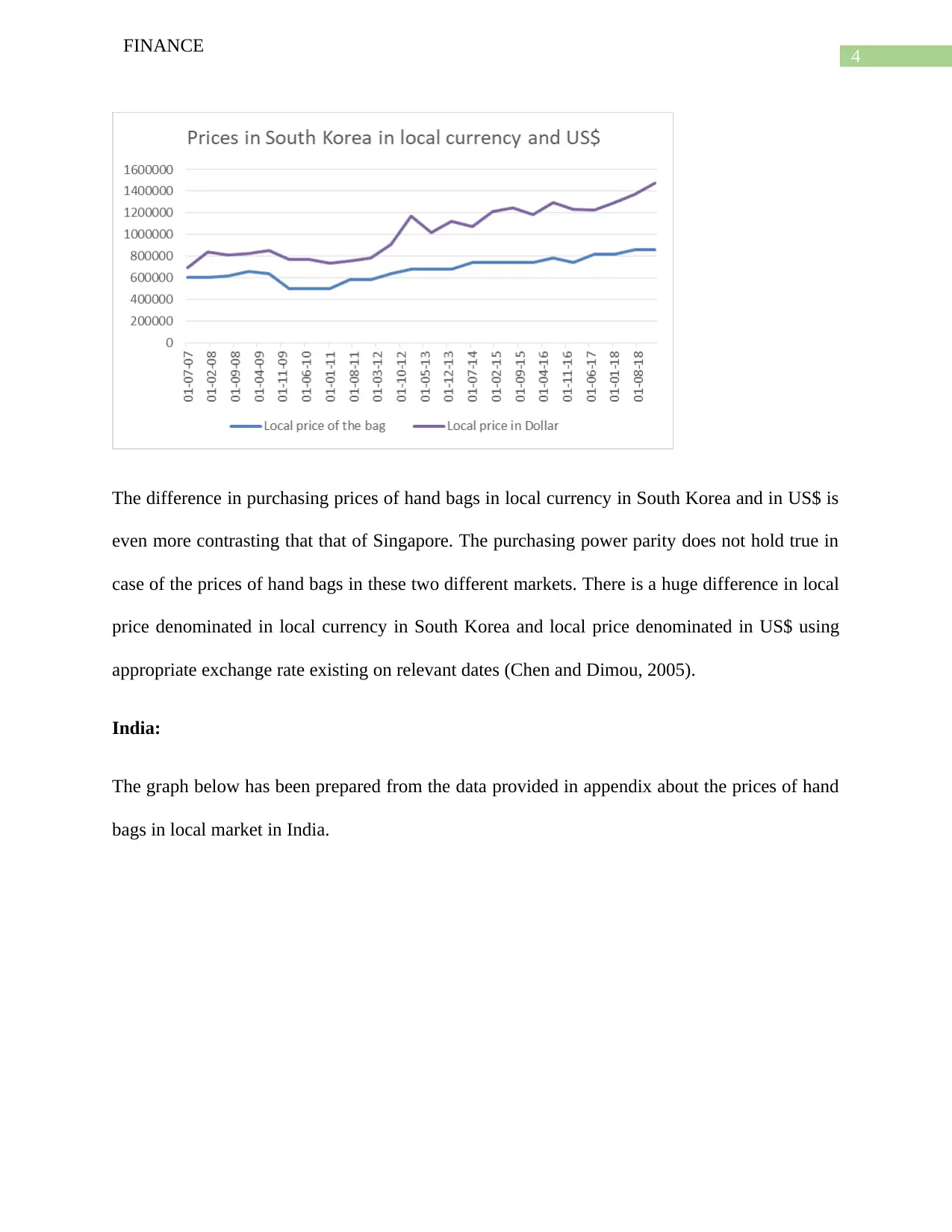
4
FINANCE
The difference in purchasing prices of hand bags in local currency in South Korea and in US$ is
even more contrasting that that of Singapore. The purchasing power parity does not hold true in
case of the prices of hand bags in these two different markets. There is a huge difference in local
price denominated in local currency in South Korea and local price denominated in US$ using
appropriate exchange rate existing on relevant dates (Chen and Dimou, 2005).
India:
The graph below has been prepared from the data provided in appendix about the prices of hand
bags in local market in India.
FINANCE
The difference in purchasing prices of hand bags in local currency in South Korea and in US$ is
even more contrasting that that of Singapore. The purchasing power parity does not hold true in
case of the prices of hand bags in these two different markets. There is a huge difference in local
price denominated in local currency in South Korea and local price denominated in US$ using
appropriate exchange rate existing on relevant dates (Chen and Dimou, 2005).
India:
The graph below has been prepared from the data provided in appendix about the prices of hand
bags in local market in India.
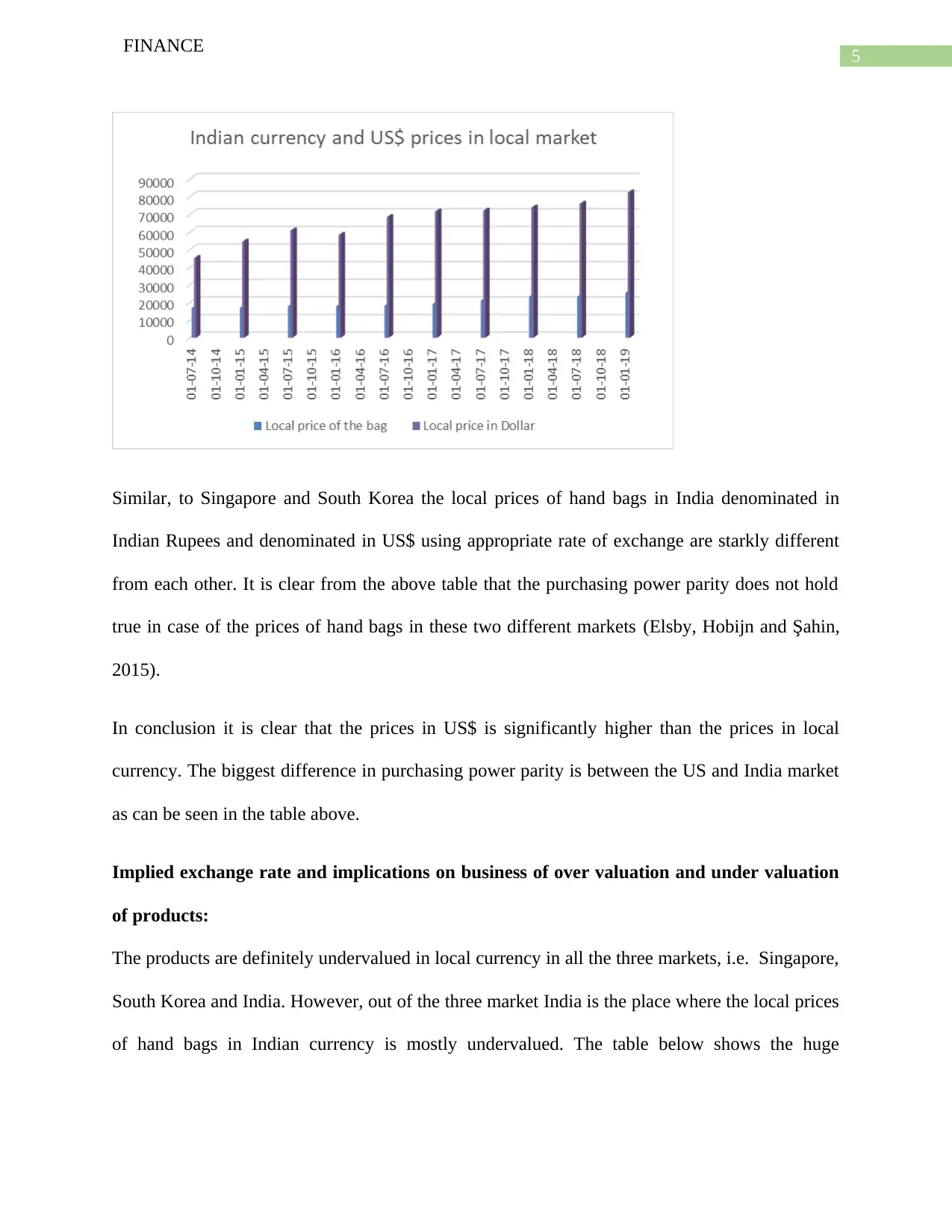
5
FINANCE
Similar, to Singapore and South Korea the local prices of hand bags in India denominated in
Indian Rupees and denominated in US$ using appropriate rate of exchange are starkly different
from each other. It is clear from the above table that the purchasing power parity does not hold
true in case of the prices of hand bags in these two different markets (Elsby, Hobijn and Şahin,
2015).
In conclusion it is clear that the prices in US$ is significantly higher than the prices in local
currency. The biggest difference in purchasing power parity is between the US and India market
as can be seen in the table above.
Implied exchange rate and implications on business of over valuation and under valuation
of products:
The products are definitely undervalued in local currency in all the three markets, i.e. Singapore,
South Korea and India. However, out of the three market India is the place where the local prices
of hand bags in Indian currency is mostly undervalued. The table below shows the huge
FINANCE
Similar, to Singapore and South Korea the local prices of hand bags in India denominated in
Indian Rupees and denominated in US$ using appropriate rate of exchange are starkly different
from each other. It is clear from the above table that the purchasing power parity does not hold
true in case of the prices of hand bags in these two different markets (Elsby, Hobijn and Şahin,
2015).
In conclusion it is clear that the prices in US$ is significantly higher than the prices in local
currency. The biggest difference in purchasing power parity is between the US and India market
as can be seen in the table above.
Implied exchange rate and implications on business of over valuation and under valuation
of products:
The products are definitely undervalued in local currency in all the three markets, i.e. Singapore,
South Korea and India. However, out of the three market India is the place where the local prices
of hand bags in Indian currency is mostly undervalued. The table below shows the huge
⊘ This is a preview!⊘
Do you want full access?
Subscribe today to unlock all pages.

Trusted by 1+ million students worldwide
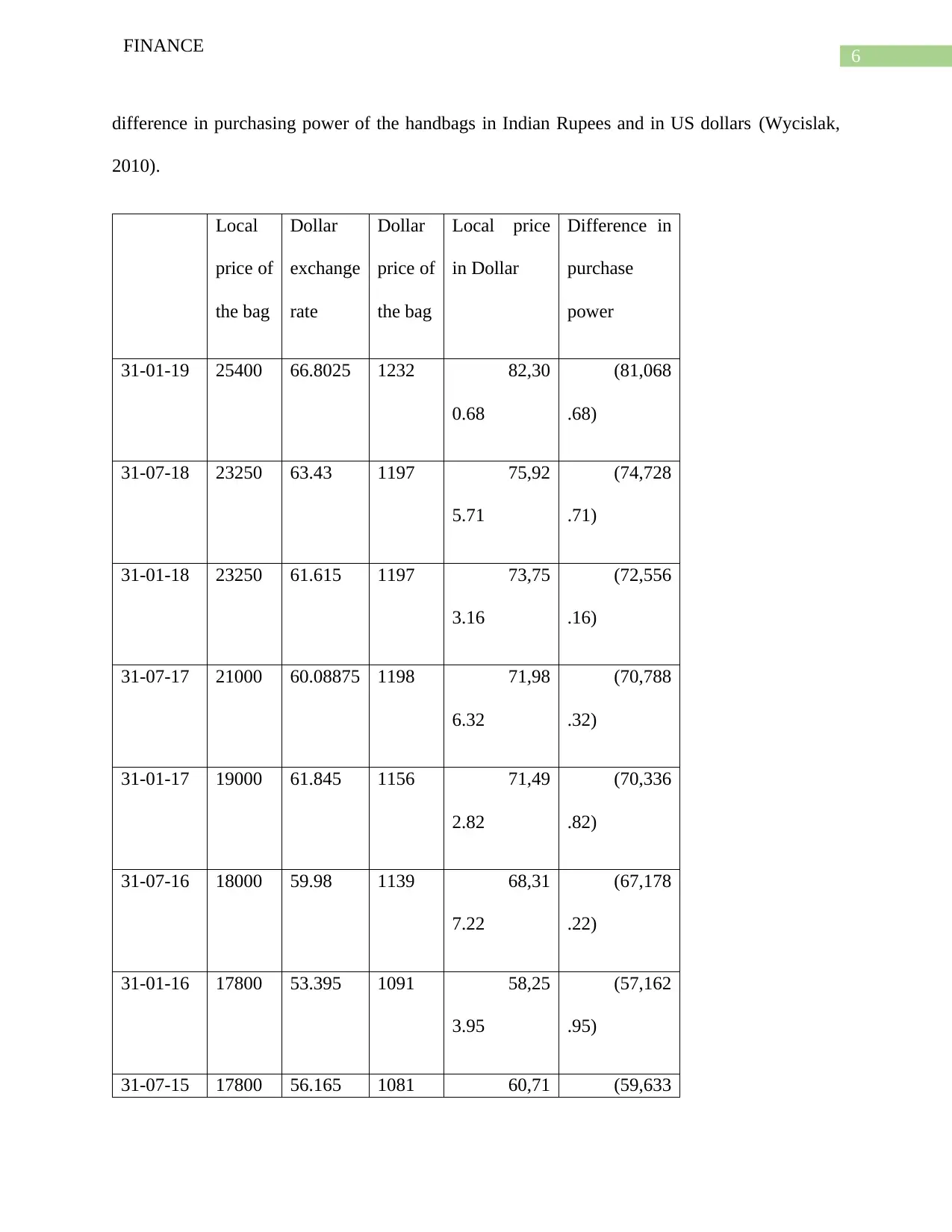
6
FINANCE
difference in purchasing power of the handbags in Indian Rupees and in US dollars (Wycislak,
2010).
Local
price of
the bag
Dollar
exchange
rate
Dollar
price of
the bag
Local price
in Dollar
Difference in
purchase
power
31-01-19 25400 66.8025 1232 82,30
0.68
(81,068
.68)
31-07-18 23250 63.43 1197 75,92
5.71
(74,728
.71)
31-01-18 23250 61.615 1197 73,75
3.16
(72,556
.16)
31-07-17 21000 60.08875 1198 71,98
6.32
(70,788
.32)
31-01-17 19000 61.845 1156 71,49
2.82
(70,336
.82)
31-07-16 18000 59.98 1139 68,31
7.22
(67,178
.22)
31-01-16 17800 53.395 1091 58,25
3.95
(57,162
.95)
31-07-15 17800 56.165 1081 60,71 (59,633
FINANCE
difference in purchasing power of the handbags in Indian Rupees and in US dollars (Wycislak,
2010).
Local
price of
the bag
Dollar
exchange
rate
Dollar
price of
the bag
Local price
in Dollar
Difference in
purchase
power
31-01-19 25400 66.8025 1232 82,30
0.68
(81,068
.68)
31-07-18 23250 63.43 1197 75,92
5.71
(74,728
.71)
31-01-18 23250 61.615 1197 73,75
3.16
(72,556
.16)
31-07-17 21000 60.08875 1198 71,98
6.32
(70,788
.32)
31-01-17 19000 61.845 1156 71,49
2.82
(70,336
.82)
31-07-16 18000 59.98 1139 68,31
7.22
(67,178
.22)
31-01-16 17800 53.395 1091 58,25
3.95
(57,162
.95)
31-07-15 17800 56.165 1081 60,71 (59,633
Paraphrase This Document
Need a fresh take? Get an instant paraphrase of this document with our AI Paraphraser
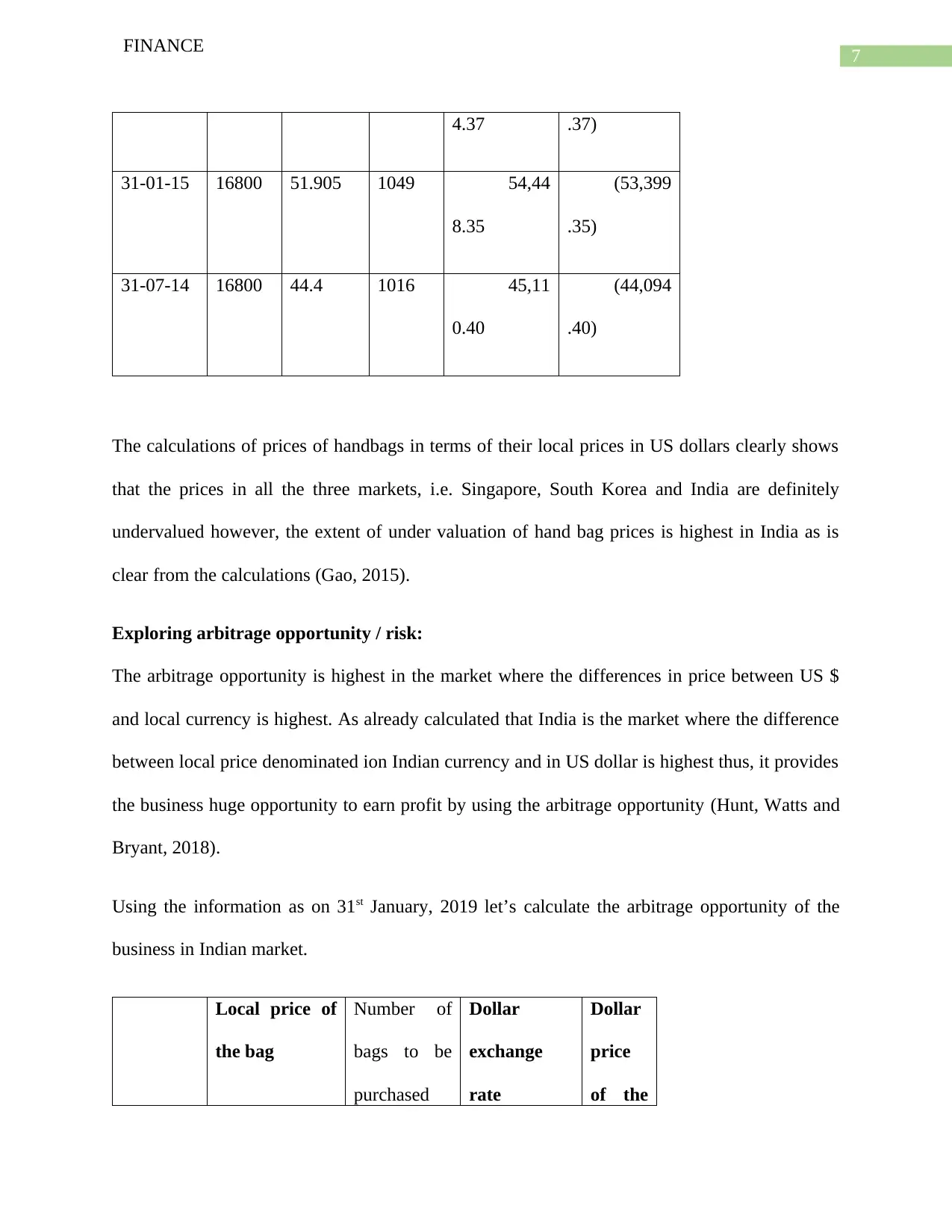
7
FINANCE
4.37 .37)
31-01-15 16800 51.905 1049 54,44
8.35
(53,399
.35)
31-07-14 16800 44.4 1016 45,11
0.40
(44,094
.40)
The calculations of prices of handbags in terms of their local prices in US dollars clearly shows
that the prices in all the three markets, i.e. Singapore, South Korea and India are definitely
undervalued however, the extent of under valuation of hand bag prices is highest in India as is
clear from the calculations (Gao, 2015).
Exploring arbitrage opportunity / risk:
The arbitrage opportunity is highest in the market where the differences in price between US $
and local currency is highest. As already calculated that India is the market where the difference
between local price denominated ion Indian currency and in US dollar is highest thus, it provides
the business huge opportunity to earn profit by using the arbitrage opportunity (Hunt, Watts and
Bryant, 2018).
Using the information as on 31st January, 2019 let’s calculate the arbitrage opportunity of the
business in Indian market.
Local price of
the bag
Number of
bags to be
purchased
Dollar
exchange
rate
Dollar
price
of the
FINANCE
4.37 .37)
31-01-15 16800 51.905 1049 54,44
8.35
(53,399
.35)
31-07-14 16800 44.4 1016 45,11
0.40
(44,094
.40)
The calculations of prices of handbags in terms of their local prices in US dollars clearly shows
that the prices in all the three markets, i.e. Singapore, South Korea and India are definitely
undervalued however, the extent of under valuation of hand bag prices is highest in India as is
clear from the calculations (Gao, 2015).
Exploring arbitrage opportunity / risk:
The arbitrage opportunity is highest in the market where the differences in price between US $
and local currency is highest. As already calculated that India is the market where the difference
between local price denominated ion Indian currency and in US dollar is highest thus, it provides
the business huge opportunity to earn profit by using the arbitrage opportunity (Hunt, Watts and
Bryant, 2018).
Using the information as on 31st January, 2019 let’s calculate the arbitrage opportunity of the
business in Indian market.
Local price of
the bag
Number of
bags to be
purchased
Dollar
exchange
rate
Dollar
price
of the
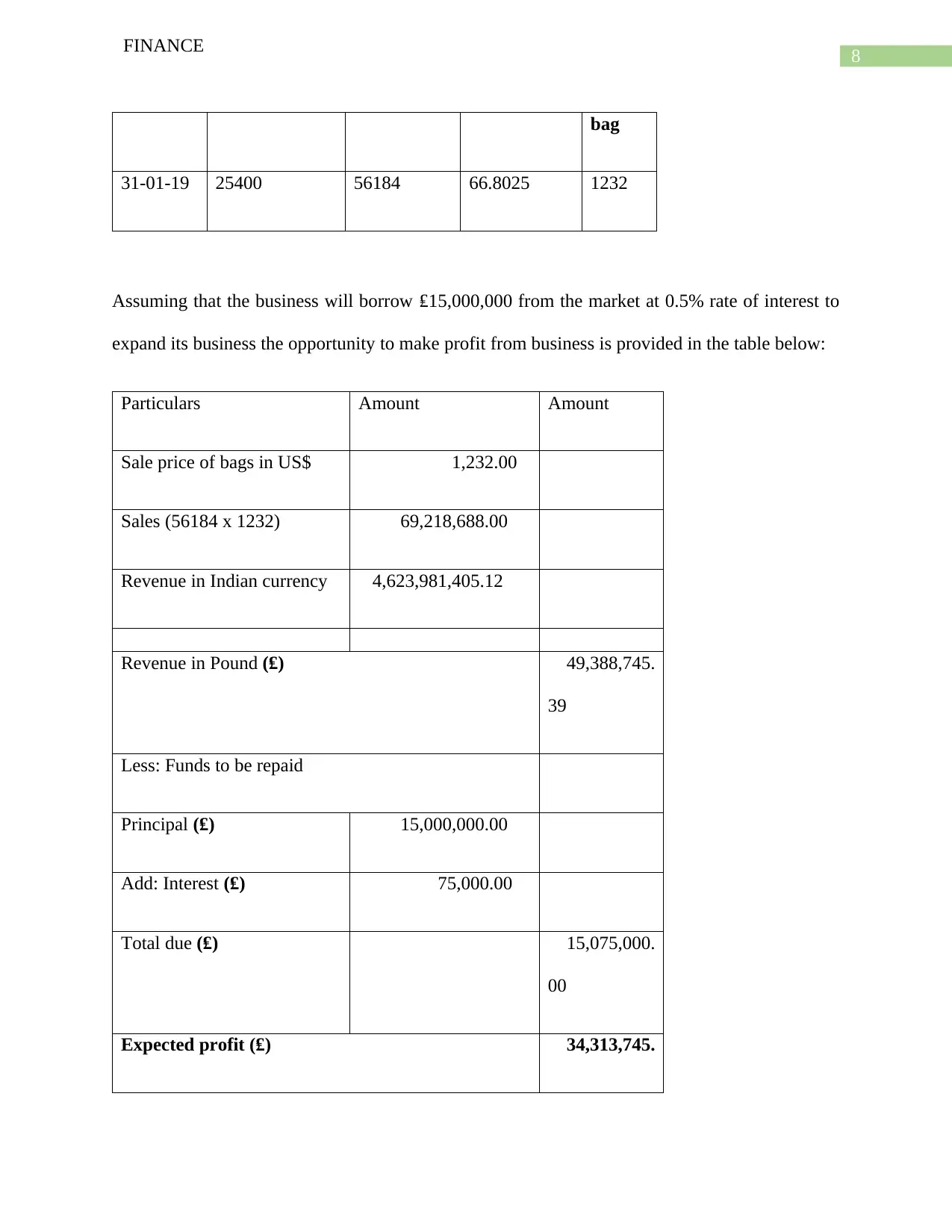
8
FINANCE
bag
31-01-19 25400 56184 66.8025 1232
Assuming that the business will borrow ₤15,000,000 from the market at 0.5% rate of interest to
expand its business the opportunity to make profit from business is provided in the table below:
Particulars Amount Amount
Sale price of bags in US$ 1,232.00
Sales (56184 x 1232) 69,218,688.00
Revenue in Indian currency 4,623,981,405.12
Revenue in Pound (₤) 49,388,745.
39
Less: Funds to be repaid
Principal (₤) 15,000,000.00
Add: Interest (₤) 75,000.00
Total due (₤) 15,075,000.
00
Expected profit (₤) 34,313,745.
FINANCE
bag
31-01-19 25400 56184 66.8025 1232
Assuming that the business will borrow ₤15,000,000 from the market at 0.5% rate of interest to
expand its business the opportunity to make profit from business is provided in the table below:
Particulars Amount Amount
Sale price of bags in US$ 1,232.00
Sales (56184 x 1232) 69,218,688.00
Revenue in Indian currency 4,623,981,405.12
Revenue in Pound (₤) 49,388,745.
39
Less: Funds to be repaid
Principal (₤) 15,000,000.00
Add: Interest (₤) 75,000.00
Total due (₤) 15,075,000.
00
Expected profit (₤) 34,313,745.
⊘ This is a preview!⊘
Do you want full access?
Subscribe today to unlock all pages.

Trusted by 1+ million students worldwide

9
FINANCE
39
Thus, by investing ₤15,000,000 in Indian market the business can earn as much as
₤34,313,745.39 as profit before applicable taxes within a year. Thus, there is a huge arbitrage
opportunity to the business to borrow the necessary funds in ₤ to invest in India for expansion of
business to earn significant amount of profit on such investment (Law, 2019).
Business implications of CIA and UIA:
Covered interest arbitrage (CIA) and Uncovered interest arbitrage (UIA) allows switching
interest rates from domestic currency to foreign currency and vice a verse. These are generally
used when there is significant difference between interest rates in domestic and foreign
currencies. As can be seen that there is significant difference between interest rates in pound
sterling (₤) and foreign currencies thus, use of CIA and UIA according to the requirements of the
business will be very helpful to minimize the risk of interest rate fluctuations and in reducing
interest liabilities towards amount borrowed for investment. Thus, the business implications are
significant provided these are used effectively by the business. The difference in rates of interest
between pound sterling (₤) and Indian Rupees is highest with 0.5% and 7% respectively the
business should use CIA and UIA to minimize the expenditures in respect of interest on
borrowed funds for business expansion (Padmalia, 2014).
Tracking the monetary markets:
Tracking monetary markets is extremely important for a business organization which is looking
to expand its business to different places outside the domestic borders. In this case the three
probable markets all have strong monetary markets. Still it is very important for the business to
FINANCE
39
Thus, by investing ₤15,000,000 in Indian market the business can earn as much as
₤34,313,745.39 as profit before applicable taxes within a year. Thus, there is a huge arbitrage
opportunity to the business to borrow the necessary funds in ₤ to invest in India for expansion of
business to earn significant amount of profit on such investment (Law, 2019).
Business implications of CIA and UIA:
Covered interest arbitrage (CIA) and Uncovered interest arbitrage (UIA) allows switching
interest rates from domestic currency to foreign currency and vice a verse. These are generally
used when there is significant difference between interest rates in domestic and foreign
currencies. As can be seen that there is significant difference between interest rates in pound
sterling (₤) and foreign currencies thus, use of CIA and UIA according to the requirements of the
business will be very helpful to minimize the risk of interest rate fluctuations and in reducing
interest liabilities towards amount borrowed for investment. Thus, the business implications are
significant provided these are used effectively by the business. The difference in rates of interest
between pound sterling (₤) and Indian Rupees is highest with 0.5% and 7% respectively the
business should use CIA and UIA to minimize the expenditures in respect of interest on
borrowed funds for business expansion (Padmalia, 2014).
Tracking the monetary markets:
Tracking monetary markets is extremely important for a business organization which is looking
to expand its business to different places outside the domestic borders. In this case the three
probable markets all have strong monetary markets. Still it is very important for the business to
Paraphrase This Document
Need a fresh take? Get an instant paraphrase of this document with our AI Paraphraser
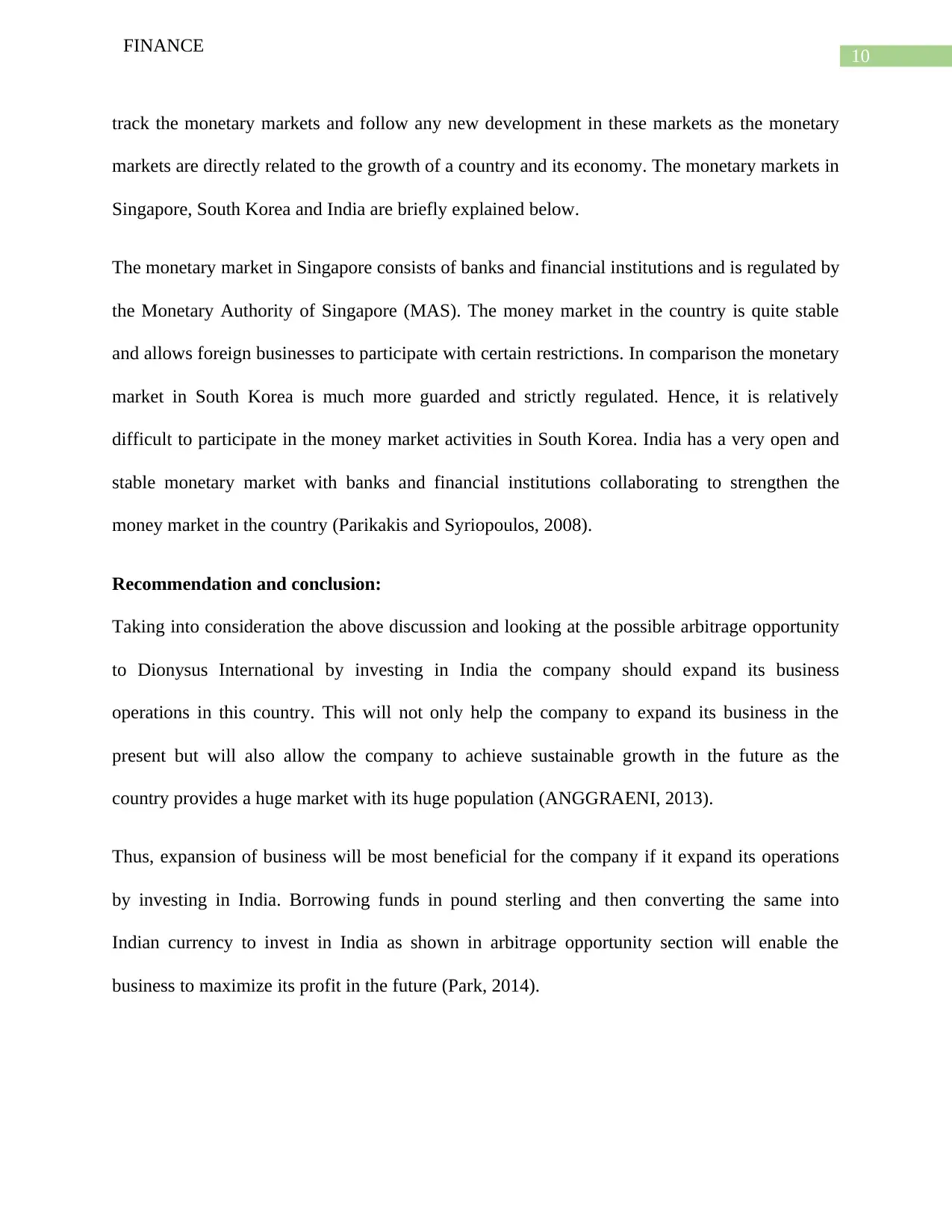
10
FINANCE
track the monetary markets and follow any new development in these markets as the monetary
markets are directly related to the growth of a country and its economy. The monetary markets in
Singapore, South Korea and India are briefly explained below.
The monetary market in Singapore consists of banks and financial institutions and is regulated by
the Monetary Authority of Singapore (MAS). The money market in the country is quite stable
and allows foreign businesses to participate with certain restrictions. In comparison the monetary
market in South Korea is much more guarded and strictly regulated. Hence, it is relatively
difficult to participate in the money market activities in South Korea. India has a very open and
stable monetary market with banks and financial institutions collaborating to strengthen the
money market in the country (Parikakis and Syriopoulos, 2008).
Recommendation and conclusion:
Taking into consideration the above discussion and looking at the possible arbitrage opportunity
to Dionysus International by investing in India the company should expand its business
operations in this country. This will not only help the company to expand its business in the
present but will also allow the company to achieve sustainable growth in the future as the
country provides a huge market with its huge population (ANGGRAENI, 2013).
Thus, expansion of business will be most beneficial for the company if it expand its operations
by investing in India. Borrowing funds in pound sterling and then converting the same into
Indian currency to invest in India as shown in arbitrage opportunity section will enable the
business to maximize its profit in the future (Park, 2014).
FINANCE
track the monetary markets and follow any new development in these markets as the monetary
markets are directly related to the growth of a country and its economy. The monetary markets in
Singapore, South Korea and India are briefly explained below.
The monetary market in Singapore consists of banks and financial institutions and is regulated by
the Monetary Authority of Singapore (MAS). The money market in the country is quite stable
and allows foreign businesses to participate with certain restrictions. In comparison the monetary
market in South Korea is much more guarded and strictly regulated. Hence, it is relatively
difficult to participate in the money market activities in South Korea. India has a very open and
stable monetary market with banks and financial institutions collaborating to strengthen the
money market in the country (Parikakis and Syriopoulos, 2008).
Recommendation and conclusion:
Taking into consideration the above discussion and looking at the possible arbitrage opportunity
to Dionysus International by investing in India the company should expand its business
operations in this country. This will not only help the company to expand its business in the
present but will also allow the company to achieve sustainable growth in the future as the
country provides a huge market with its huge population (ANGGRAENI, 2013).
Thus, expansion of business will be most beneficial for the company if it expand its operations
by investing in India. Borrowing funds in pound sterling and then converting the same into
Indian currency to invest in India as shown in arbitrage opportunity section will enable the
business to maximize its profit in the future (Park, 2014).

11
FINANCE
References:
ANGGRAENI, _. (2013). The Effect of the Third Party Fund: Its Distribution and Fluctuation on
the BOPO Growth at Commercial Foreign Exchange Banks in Indonesia. IAMURE International
Journal of Business and Management, 5(1), pp.21-27.
Chen, J. and Dimou, I. (2005). Expansion strategy of international hotel firms. Journal of
Business Research, 58(12), pp.1730-1740.
Chen, J. and Feng, J. (2009). Competence Set Expansion Strategy and Application with General
Connectivity Parameters. International Journal of Business and Management, 4(8), pp.17-27.
Elsby, M., Hobijn, B. and Şahin, A. (2015). On the importance of the participation margin for
labor market fluctuations. Journal of Monetary Economics, 72(78), pp.64-82.
Gao, H. (2015). Effects of RMB Exchange Rate Fluctuation on China’s Foreign Trade. Archives
of Current Research International, 2(2), pp.54-58.
Hunt, I., Watts, A. and Bryant, S. (2018). Walmart’s international expansion: successes and
miscalculations. Journal of Business Strategy, 39(2), pp.22-29.
Law, C. (2019). Asymmetric impacts of foreign exchange reserves on the exchange rate in
Korea. International Journal of Economics and Business Research, 18(1), p.73.
Padmalia, M. (2014). THE STRATEGY OF ONLINE START-UP BUSINESS EXPANSION
THROUGH POP-UP STORES INNOVATION. Journal of Management and Business, 13(2),
pp.12-27.
FINANCE
References:
ANGGRAENI, _. (2013). The Effect of the Third Party Fund: Its Distribution and Fluctuation on
the BOPO Growth at Commercial Foreign Exchange Banks in Indonesia. IAMURE International
Journal of Business and Management, 5(1), pp.21-27.
Chen, J. and Dimou, I. (2005). Expansion strategy of international hotel firms. Journal of
Business Research, 58(12), pp.1730-1740.
Chen, J. and Feng, J. (2009). Competence Set Expansion Strategy and Application with General
Connectivity Parameters. International Journal of Business and Management, 4(8), pp.17-27.
Elsby, M., Hobijn, B. and Şahin, A. (2015). On the importance of the participation margin for
labor market fluctuations. Journal of Monetary Economics, 72(78), pp.64-82.
Gao, H. (2015). Effects of RMB Exchange Rate Fluctuation on China’s Foreign Trade. Archives
of Current Research International, 2(2), pp.54-58.
Hunt, I., Watts, A. and Bryant, S. (2018). Walmart’s international expansion: successes and
miscalculations. Journal of Business Strategy, 39(2), pp.22-29.
Law, C. (2019). Asymmetric impacts of foreign exchange reserves on the exchange rate in
Korea. International Journal of Economics and Business Research, 18(1), p.73.
Padmalia, M. (2014). THE STRATEGY OF ONLINE START-UP BUSINESS EXPANSION
THROUGH POP-UP STORES INNOVATION. Journal of Management and Business, 13(2),
pp.12-27.
⊘ This is a preview!⊘
Do you want full access?
Subscribe today to unlock all pages.

Trusted by 1+ million students worldwide
1 out of 21
Related Documents
Your All-in-One AI-Powered Toolkit for Academic Success.
+13062052269
info@desklib.com
Available 24*7 on WhatsApp / Email
![[object Object]](/_next/static/media/star-bottom.7253800d.svg)
Unlock your academic potential
Copyright © 2020–2025 A2Z Services. All Rights Reserved. Developed and managed by ZUCOL.





